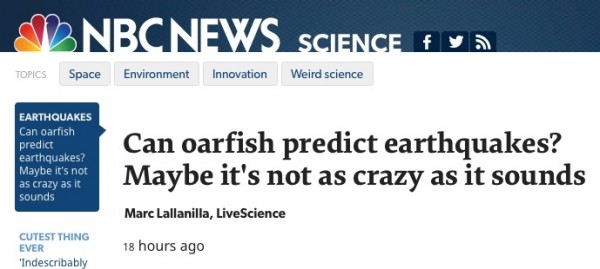 One of the courses I’m teaching each semester here in Kent is called ‘Earth Dynamics’: an introductory-level geology course aimed at the broader undergraduate population. With that in mind, I try to identify and highlight areas where the topic at hand may intersect with the everyday lives of my students. Thus when, last week, we covered earthquakes, I had to address the thorny topic of earthquake prediction. I’ve covered this topic many, many times here on the blog, which has probably not only emphasised to me the importance of covering it in class, but also made me perhaps a little more ranty about it than is healthy. My rant can be summarised thusly:
One of the courses I’m teaching each semester here in Kent is called ‘Earth Dynamics’: an introductory-level geology course aimed at the broader undergraduate population. With that in mind, I try to identify and highlight areas where the topic at hand may intersect with the everyday lives of my students. Thus when, last week, we covered earthquakes, I had to address the thorny topic of earthquake prediction. I’ve covered this topic many, many times here on the blog, which has probably not only emphasised to me the importance of covering it in class, but also made me perhaps a little more ranty about it than is healthy. My rant can be summarised thusly:
-
It is important to distinguish between specific, short-term predictions (‘that fault will rupture in a magnitude 7.5 earthquake next Friday’), and general, probabilistic, long-term predictions, or forecasts (‘this area has a 1 in 4 chance of experiencing a magnitude 7 or greater earthquake in the next 30 years’). We presently have no ability – or inkling of an ability – with regards to the former. Even with the latter, we face severe limitations due to the lack of a long-term earthquake record in most regions, but it is currently the only game in town.
-
Don’t believe anyone who claims they can accurately predict earthquakes over the short-term. These people are at best extremely misguided, and at worst frauds and charlatans. The only way that they are successful is to make loose ‘predictions’ in a seismically active area and adopt very broad criteria for ‘success’ (‘That magnitude 5 200 km from where I said there’d be a magnitude 8 was totally right. I’m a genius!’). People claiming the prospect of an even bigger shock in the aftermath of a big quake, such as seems to have been the case for last week’s destructive M 7.2 in the Philippines, operate from a similar playbook.

Folks producing daily earthquake predictions – this is you. And you should be taken about as seriously. Source
- When you read headlines with the form ‘Can x predict earthquakes?’, the answer is always ‘NO’. For any value of x, be it planetary alignments, animal behaviour, weather, foreshock patterns, radon gas emissions, ionospheric disturbances, low frequency electromagnetic signals, anything, the answer is still ‘NO’.
Sadly, such headlines are all-too-common, as NBC proved this morning:

Yes. Yes it is.
By this stage, my response should not surprise you:
Over at Deep Sea News, Craig deconstructs this particular example quite nicely, but the underlying problem is always the same. The association is always post-hoc: these ‘precursor’ events are only claimed as such when people look backwards after a large earthquake has already occurred – and a more detailed look always reveals a huge problem with false positives (signal, but no large earthquake) and false negatives (no signal, but a large earthquake anyway). Thus, even if the weirdly behaving animals, or infra-red anomalies in the atmosphere, or strange foreshock patterns, are actually connected to an imminent destructive earthquake, we have no understanding of how and why, so we currently have no way of systematically using future observations to make future predictions. The only thing more annoying than the uncritical discussion of claimed earthquake precursors in the media is the assumption that, if it is valid, it’s then an easy step to building a short-term earthquake warning system. It is not.
Despite my obviously hardline stance on these matters, I am happy to concede that all this may change in the future. It’s certainly possible that we can pick up valid signals associated with incipient fault rupture at depth, and we may eventually understand the processes that generate them enough to – potentially – weed out the false positives well enough to make them useful for shorter term forecasting. But I wouldn’t hold your breath – earthquake scientists have been looking and hoping for such tools for decades, and even the ones that have appeared promising initially have failed to hold up to scrutiny in the long run.
Not only can oarfish not predict earthquakes – neither can we.
 Hydraulics
Hydraulics is a topic in applied science and engineering dealing with the mechanical properties of liquids. At a very basic level hydraul…
Hydraulics
Hydraulics is a topic in applied science and engineering dealing with the mechanical properties of liquids. At a very basic level hydraul… Hydrology – Wikipedia, the free encyclopedia
Hydrology is the study of the movement, distribution, and quality of water on Earth and other planets, including the hydrologic cycle, wa…
Hydrology – Wikipedia, the free encyclopedia
Hydrology is the study of the movement, distribution, and quality of water on Earth and other planets, including the hydrologic cycle, wa… Halloween Costumes for Water and WASH Wonks: 2012 edition
Have we got a treat for you! With Halloween just two weeks off, you may be nearing a costume-ready state, but we believe your costume sho…
Halloween Costumes for Water and WASH Wonks: 2012 edition
Have we got a treat for you! With Halloween just two weeks off, you may be nearing a costume-ready state, but we believe your costume sho…








